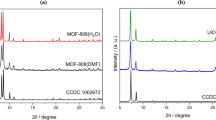Abstract
The sorption and permeation properties of CO2 and CH4 for synthesized brominated polysulfone, BPSf (bromobisphenol A polysulfone) were measured, and compared with the values for PSf (bisphenol A polysulfone), MPSf (bisphenol A methylated polysulfone) and TMSPSf (bisphenol A trimethylsilylated polysulfone) to investigate the structure-property relationships. Especially, the effect of polarity of substituents on the transport properties was studied. The effect of operating pressure on the permeation properties of polysulfones was examined. The permeation properties for a mixture of CO2 and CH4 were also measured, and these results were compared with those obtained from the experiments of pure gases. The sorbed concentrations and permeability coefficients are well fitted to the dual mode model. The permeability coefficients of each gas of a binary mixture are less than those of pure gases, and the extent of reduction in permeability coefficient is larger for less permeable polymer. The ideal separation factor for four polysulfones increases in the following order: TMSPSf< PSf< BPSf< MPSf. The ideal separation factor for BPSf is higher than other polysulfones having similar permeability coefficients of CO2 with BPSf. It can be explained that the strong polarity of bromine in BPSf increases cohesive energy density of polymer, and reduces the chain packing-inhibiting ability. The ranking of permeability coefficient correlates well with fractional free volume. The variation of d-spacing is not consistent with the permeability coefficient.
Similar content being viewed by others
References
Aitken, C. L., Koros, W. J. and Paul, D. R., “Effect of Structural Symmetry on Gas Transport Properties of Polysulfones,”Macromolecules,25, 3424 (1992).
Bae, S. Y., Kim, H. T. and Kumazawa, H., “Transport Phenomena in Gas Permeation through Glassy Polymer Membranes with Concentration-Dependent Sorption and Diffusion Parameters,”Korean J. Chem. Eng.,11, 211 (1994).
Bae, S. Y., Lee, K. H., Yi, S. C., Kim, H. T., Kim, Y. H. and Kumazawa, H., “CO2 and N2Gas Sorption and Permeation Behavior of Chotosan Membrane,”Korean J. Chem. Eng.,15, 223 (1998).
Balta-Calleja, F. J. and Vonk, C. G., “The Theory of Coherent X-ray Scattering,” in “X-ray Scattering of Synthetic Polymers,” Elsevier, Amsterdam, The Netherlands, 1 (1989).
Bhide, B. D. and Stern, S. A., “Membrane Processes for the Removal of Acid Gases from Natural Gas. I. Process Configurations and Optimization of Operating Conditions,”J. Membrane Sci.,81, 209 (1993).
Bollinger, W. A., MacLean, D. L. and Narayan, R. S., “Separation Systems for Oil Refining and Production,”Chem. Eng. Prog.,Oct. 27 (1982).
Bondi, A., “Van der Waals Volume and Radii,”J. Phys. Chem.,68, 441 (1964).
Chern, R. T., Koros, W. J., Yuri, B., Hopenberg, H. B. and Stanett, V. T., “Selective Permeation of CO2 and CH4 through Kapton Polyimide; Effects of Penetrant Competition and Gas Phase Nonideality,”J. Polym. Sci., Part B, Polym. Phys. Ed.,22, 1061 (1984).
Dhingra, S. and Marand, E., “Mixed Gas Transport Study through Polymer Membranes,”J. Membrane Sci.,141, 45 (1998).
Ghosal, K., Chern, R. T., Freeman, B. D., Daly, W. H. and Negulescu, I. I., “Effect of Basic Substituents on Gas Sorption and Permeation in Polysulfones,”Macromolecules,29, 4360 (1996).
Guiver, M. D., Kutowy, O. and ApSimon, J.W., “Functional Group Polysulphones by Bromination-Metalation,”Polymer,30, 1137 (1989).
Jacobson, S. H., “Computer Assisted Analysis of X-ray Scattering from Polymeric Gas Separation and Barrier Materials,”Polym. Prepr.,32, 39 (1991).
Kim, H. J. and Hong, S. I., “The Sorption and Permeation of CO2 and CH4 for Dimethylated Polysulfone Membrane,”Korean J. Chem. Eng.,14, 168 (1997a).
Kim, H. J. and Hong, S. I., “The Transport Properties of CO2 and CH4 for TMSPSf Membrane,”Korean J. Chem. Eng.,14, 382 (1997b).
Kim, H. J., Shin, W. C., Yu, B. S. and Hong, S. I., “Facilitated Transport of Oxygen for Polysulfone Membranes Containing Metalloporphyrin Complexes,”HWAHAK KONGHAK,34, 564 (1996).
Kim, T. H., Koros, W. J., Husk, G. R. and O’Brien, K. C., “Relationship between Gas Separation Properties and Chemical Structure in a Series of Aromatic Polyimides,”J. Membrane Sci.,37, 45 (1988).
Kesting, R. E. and Fritsche, A. K., “Theory of Gas Transport in Membranes,” in “Polymeric Gas Separation Membranes,” John Wiley & Sons, New York, NY, 19 (1993).
Koros, W. J., “Models for Sorption of Mixed Gases in Glassy Polymers,”J. Polym. Sci., Part B, Polym. Phys. Ed.,18, 981 (1980).
Koros, W. J. and Chern, R. T., “Separation of Gaseous Mixtures Using Polymer Membranes,” in Rousseau, R. W. (Ed.), “Handbook of Separation Process,” Wiley-Interscience, New York, NY, 862 (1987).
Koros, W. J. and Fleming, G. K., “Membrane-based Gas Separation,”J. Membrane Sci.,83, 1 (1993).
McHattie, J. S., Koros, W. J. and Paul, D. R., “Gas Transport Properties of Polysulphones: 1. Role of Symmetry of Methyl Group Placement on Bisphenol Rings,”Polymer,32, 840 (1991a).
McHattie, J. S., Koros, W. J. and Paul, D. R., “Gas Transport Properties of Polysulphones: 2. Effect of Bisphenol Connector Groups,”Polymer,32, 2618 (1991b).
McHattie, J. S., Koros, W. J. and Paul, D. R., “Gas Transport Properties of Polysulphones: 3. Comparison of Tetramethyl-Substituted Bisphenols,”Polymer,33, 1701 (1992).
Paul, D. R. and Koros, W. J., “Effect of Partially Immobilizing Sorption and Permeability on the Diffusion Time Lag,”J. Polym. Sci., Part B, Polym. Phys. Ed.,14, 675 (1976).
Pixton, M. R. and Paul, D. R., “Gas Transport Properties of Adamantane-based Polysulfones,”Polymer,36, 3165 (1995).
Rautenbach, R. and Welsch, K., “Treatment of Landfill Gas by Gas-Permeation-Pilot Plant Results and Comparison to Alternatives,”J. Membrane Sci.,87, 107 (1994).
Stern, S. A., “Polymers for Gas Separations: the Next Decade,”J. Membrane. Sci.,94, 1 (1994).
Van Krevelen, D. W., “Volumetric Properties,” in “Properties of Polymers,” Elsevier, Amsterdam, The Netherlands, 71 (1990).
Author information
Authors and Affiliations
Corresponding author
Rights and permissions
About this article
Cite this article
Kim, HJ., Hong, SI. The transport properties of CO2 and CH4 for brominated polysulfone membrane. Korean J. Chem. Eng. 16, 343–350 (1999). https://doi.org/10.1007/BF02707123
Received:
Accepted:
Issue Date:
DOI: https://doi.org/10.1007/BF02707123




